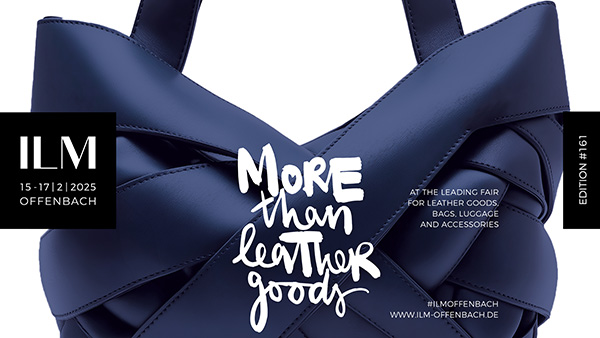One might have the idea that a trade fair is a stationary, immobile, sometimes unchanging institution that calls to itself the actors that animate it. This is not the case with Expo Riva Schuh & Gardabags, which has always been devoted to capturing the moods of the market and, to do so, moves and visits the main manufacturing countries in the footwear, handbags and accessories sphere, as well as seeking contact with the world of distribution. This is what Mauro Di Molfetta, Gardabags project manager, has also done in recent months, and we now ask him to take stock of the state of health of leather goods internationally.
Di Molfetta knows the world of handbags, accessories and luggage well by frequenting it, in different roles, for about 30 years. First as head of foreign promotion for Aimpes and Mipel, then as export manager and sales network manager for top brands in the apparel and footwear sectors, and finally as sales director of Mipel, before coming to Riva del Garda.
As part of the Expo Riva Schuh & Gardabags Around the World program, he recently visited several markets, including China, India and Turkey.
“During our travels we talked with many entrepreneurs and, for all of them, the main theme is the sharp slowdown in orders that is pushing them to look for new partners and new outlets.”
Let’s start with China…
“China is confirmed as the leader on the leather production front in terms of volume, synthetic materials and leather accessories production, and, it goes without saying, also in the production of the finished product.
During our missions to some of the most important production districts in the country, we have found that, today, companies need to travel, investigate new marketplaces and open new business channels. Basically, they have the need to find new customers. Evidently, interactions between customers and suppliers have changed as well as orders have been greatly reduced. A situation of uncertainty exacerbated by the geopolitical dynamics of war compounded by the election of the new U.S. president and the breezy policies focused on tariffs.
It is precisely the duties and rising labor costs in traditional leather manufacturing districts, where there is good production capacity and quality, that could reinforce the trend to relocate Chinese manufacturing activities to other countries, such as Vietnam, Bangladesh and India. Countries that stand to be the new frontiers of leather goods production. The dynamics of Chinese offshoring, among other things, as a side effect, is producing the growth of indigenous manufacturing entities. Starting from owning a family tannery, they are finding themselves structured as large footwear and leather goods groups.
Also worth noting is the formation of new production districts where product prices are competitive, but with lower quality.”
What characterizes India, however?
“While the tanneries are located in the Chennai area, the vast majority of production is still located in Calcutta, with companies with more industrialized processes than other districts such as those in Noida, near Dehli. It is a market characterized by many small-to-medium family businesses (in this it bears similarities to the Italian manufacturing company) devoted to the production of leather products mostly exported to the United States, the United Kingdom and Europe.
Indian companies face a variety of problems such as, for example, the sourcing of PU and small metal parts that must necessarily be purchased in China since they do not have the complete supply chain in house. In addition, they have greater constraints than standards for processing leather and raw material in general. Factor that affects production costs to the detriment of competitiveness.
Even in the case of India, which has been working with signatures for a certain type of production for years, the decline in orders for the high-end product pushes companies to look for new partners offering to work even for more commercial level orders. This is why they find Gardabags’ platform interesting as a hub where they can weave new business relationships.
It is also interesting to note the growth of the domestic market. A population with high spending capacity is expected in the future. An interesting fact when you consider that India is the most populous country in the world and more than 70 percent of the population is under 35 years old.”
One market that rose to prominence in the pandemic years and soon after is Turkey.
“Unfortunately, recent data confirm that 2024 was also not a good year for Turkey. Their exchanges have been greatly burdened by the inflationary push that has brought great fluctuations to their price lists. A situation that buyers do not like. Large Turkish manufacturers have been less affected, but small and medium-sized companies all along the supply chain have been in great difficulty. Leather goods exports have suffered declines of 20 to 30 percent. Italy remains the country with the highest share (11.3 percent), followed by Germany (10.7 percent).”
What growth markets might be surprising?
“Vietnam, after gaining good market share on footwear production, is also entering the leather goods sector. The real surprise could be Bangladesh, where there is really ferment, and Pakistan. Many are already working with international brands. We would be very pleased to bring a representation of them to Riva del Garda, and we are working in that very direction.”
Of signs of recovery, is no one talking?
“Right now, no. Stagnation is confirmed. Expo Riva Schuh & Gardabags could be a very good tool for tracking it or at least limiting its effects. The balances are very delicate and the markets are changing much faster than before. What was believed to be established until a year ago can be disproved if you are not present and constantly confronting the market thanks to platforms like our event, where you can meet the most important players from the most representative production districts.”




